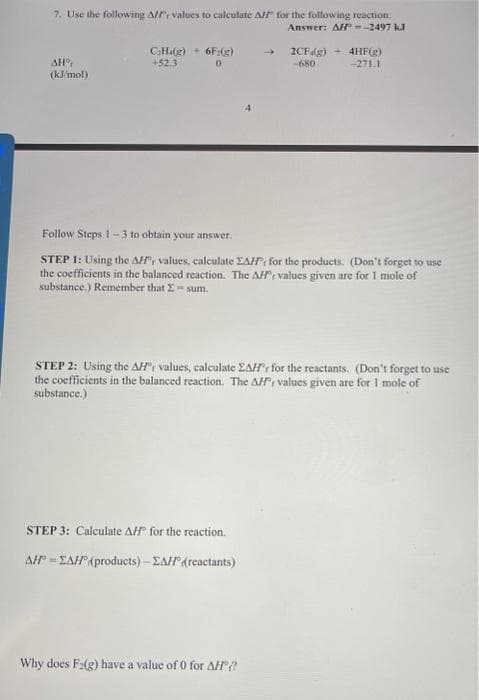7. Use the following Alf values to calculate Aff" for the following reaction: Answer: AI--2497 kJ AH, (kJ/mol) C₂Hg) + 6F:(g) +52.3 0 → Follow Steps 1-3 to obtain your answer. STEP 1: Using the AH, values, calculate EAH, for the products. (Don't forget to use the coefficients in the balanced reaction. The AHF values given are for 1 mole of substance.) Remember that 2 - sum. STEP 3: Calculate AH for the reaction. AH-ZAH (products) - ZAH(reactants) 2CF (g) + 4HF(g) -680 -271.1 STEP 2: Using the AH values, calculate EAH, for the reactants. (Don't forget to use the coefficients in the balanced reaction. The AH values given are for I mole of substance.) Why does F₂(g) have a value of 0 for AH?
7. Use the following Alf values to calculate Aff" for the following reaction: Answer: AI--2497 kJ AH, (kJ/mol) C₂Hg) + 6F:(g) +52.3 0 → Follow Steps 1-3 to obtain your answer. STEP 1: Using the AH, values, calculate EAH, for the products. (Don't forget to use the coefficients in the balanced reaction. The AHF values given are for 1 mole of substance.) Remember that 2 - sum. STEP 3: Calculate AH for the reaction. AH-ZAH (products) - ZAH(reactants) 2CF (g) + 4HF(g) -680 -271.1 STEP 2: Using the AH values, calculate EAH, for the reactants. (Don't forget to use the coefficients in the balanced reaction. The AH values given are for I mole of substance.) Why does F₂(g) have a value of 0 for AH?
Chemistry & Chemical Reactivity
9th Edition
ISBN:9781133949640
Author:John C. Kotz, Paul M. Treichel, John Townsend, David Treichel
Publisher:John C. Kotz, Paul M. Treichel, John Townsend, David Treichel
Chapter18: Principles Of Chemical Reactivity: Entropy And Free Energy
Section: Chapter Questions
Problem 16PS: Using values of fH and S, calculate rG for each of the following reactions at 25 C. (a) 2 Na(s) + 2...
Related questions
Question
Please provide all substep answer correctly.

Transcribed Image Text:7. Use the following Alf values to calculate Aff" for the following reaction:
Answer: All --2497 kJ
AH°,
(kJ/mol)
C₂H.(g) + 6F:(g)
+52.3
0
→
Follow Steps 1-3 to obtain your answer.
STEP 1: Using the AH values, calculate EAH, for the products. (Don't forget to use
the coefficients in the balanced reaction. The AHF values given are for I mole of
substance.) Remember that 2-sum.
STEP 3: Calculate AH® for the reaction.
AH-ZAH (products) - ZAH(reactants)
2CF (g) + 4HF(g)
-680
-271.1
STEP 2: Using the AH values, calculate EAH' for the reactants. (Don't forget to use
the coefficients in the balanced reaction. The AH values given are for I mole of
substance.)
Why does F₂(g) have a value of 0 for AH?
Expert Solution
This question has been solved!
Explore an expertly crafted, step-by-step solution for a thorough understanding of key concepts.
Step by step
Solved in 5 steps with 4 images

Knowledge Booster
Learn more about
Need a deep-dive on the concept behind this application? Look no further. Learn more about this topic, chemistry and related others by exploring similar questions and additional content below.Recommended textbooks for you

Chemistry & Chemical Reactivity
Chemistry
ISBN:
9781133949640
Author:
John C. Kotz, Paul M. Treichel, John Townsend, David Treichel
Publisher:
Cengage Learning

Chemistry & Chemical Reactivity
Chemistry
ISBN:
9781337399074
Author:
John C. Kotz, Paul M. Treichel, John Townsend, David Treichel
Publisher:
Cengage Learning


Chemistry & Chemical Reactivity
Chemistry
ISBN:
9781133949640
Author:
John C. Kotz, Paul M. Treichel, John Townsend, David Treichel
Publisher:
Cengage Learning

Chemistry & Chemical Reactivity
Chemistry
ISBN:
9781337399074
Author:
John C. Kotz, Paul M. Treichel, John Townsend, David Treichel
Publisher:
Cengage Learning


Chemistry
Chemistry
ISBN:
9781305957404
Author:
Steven S. Zumdahl, Susan A. Zumdahl, Donald J. DeCoste
Publisher:
Cengage Learning

Chemistry: An Atoms First Approach
Chemistry
ISBN:
9781305079243
Author:
Steven S. Zumdahl, Susan A. Zumdahl
Publisher:
Cengage Learning

Chemistry: The Molecular Science
Chemistry
ISBN:
9781285199047
Author:
John W. Moore, Conrad L. Stanitski
Publisher:
Cengage Learning